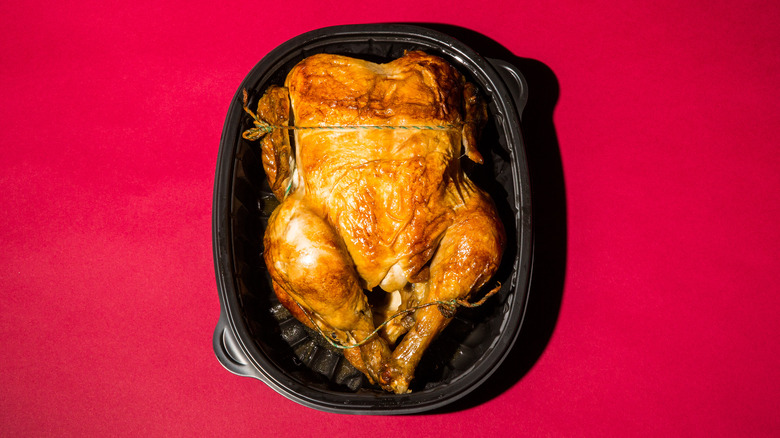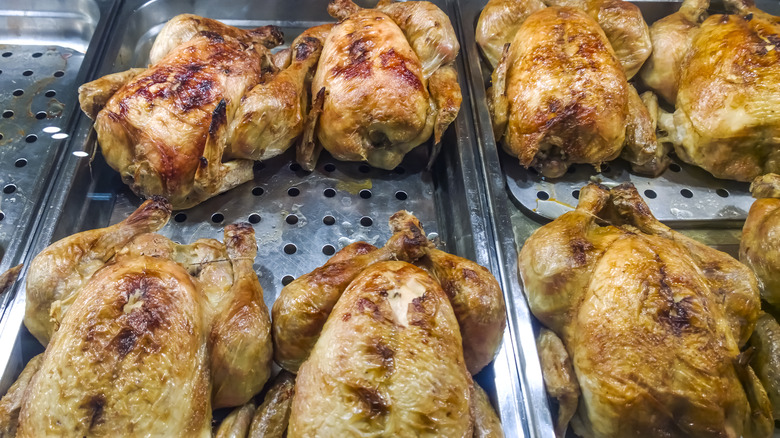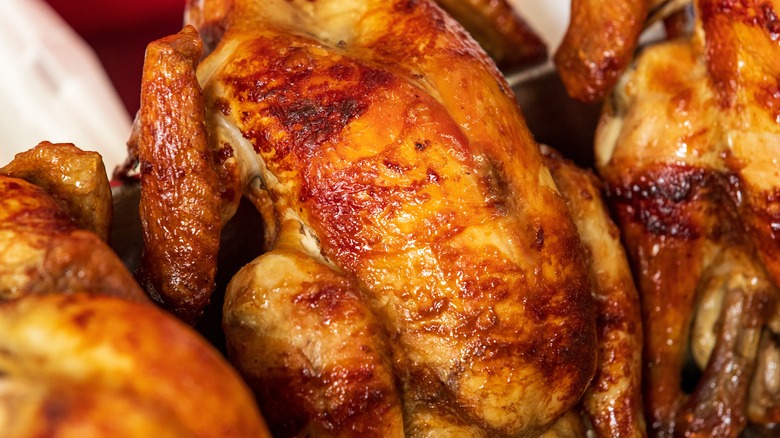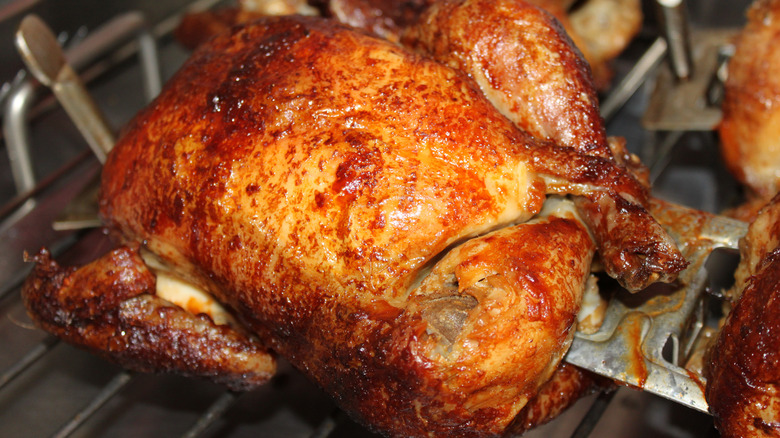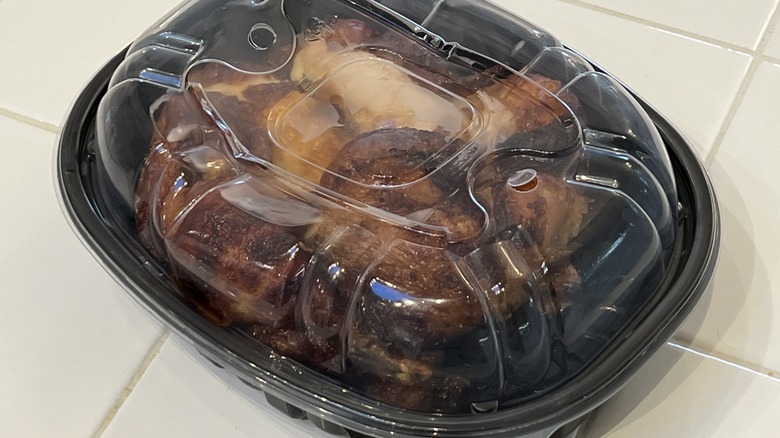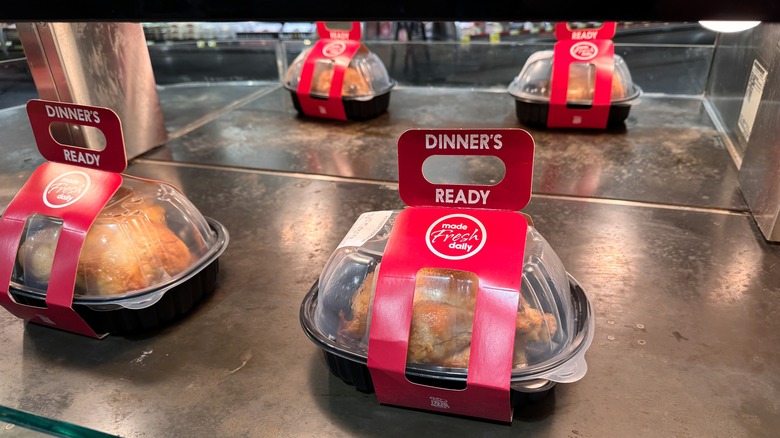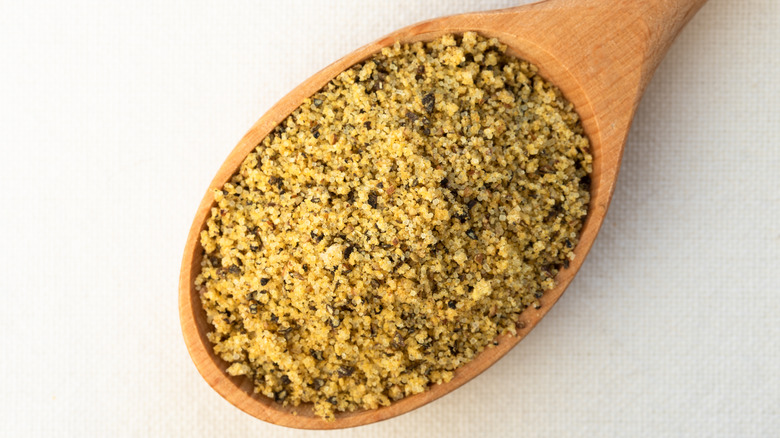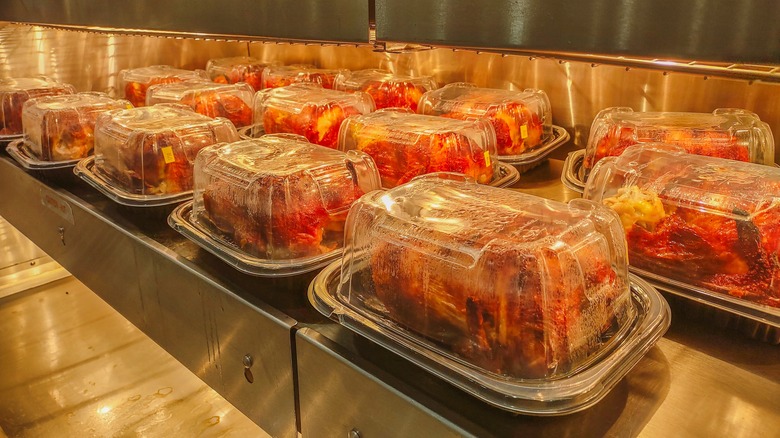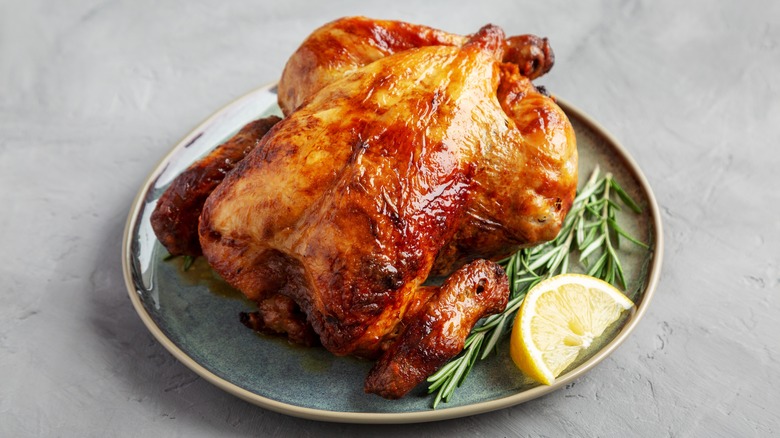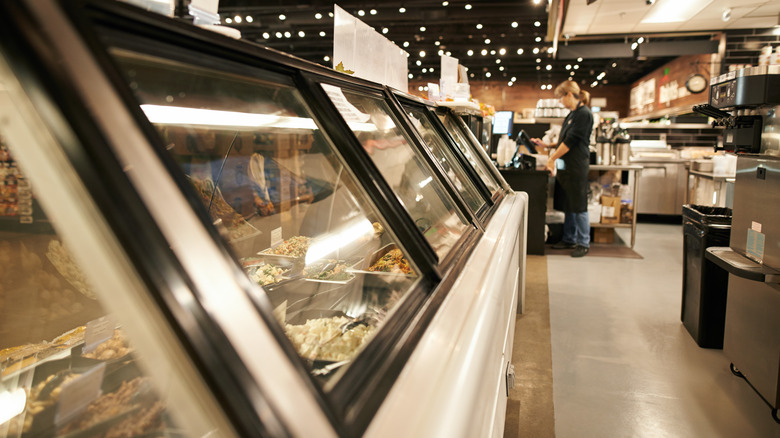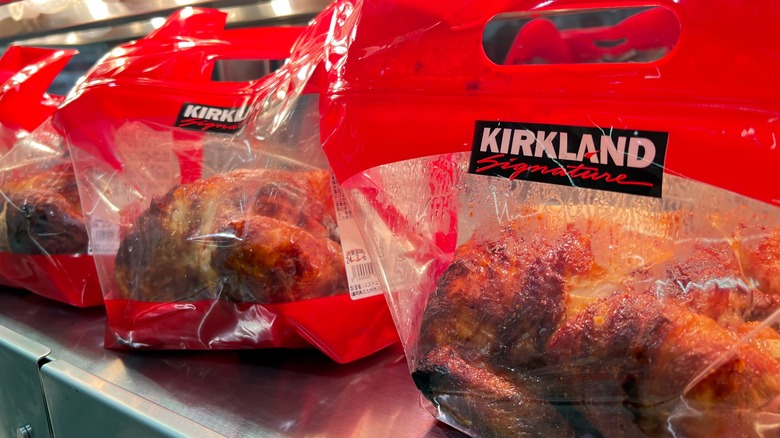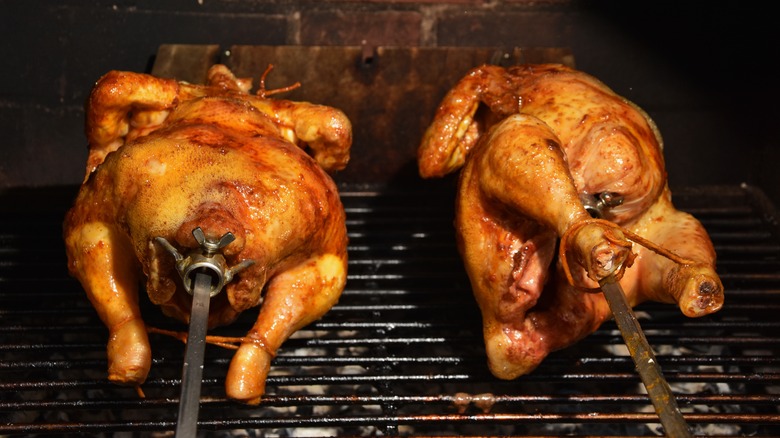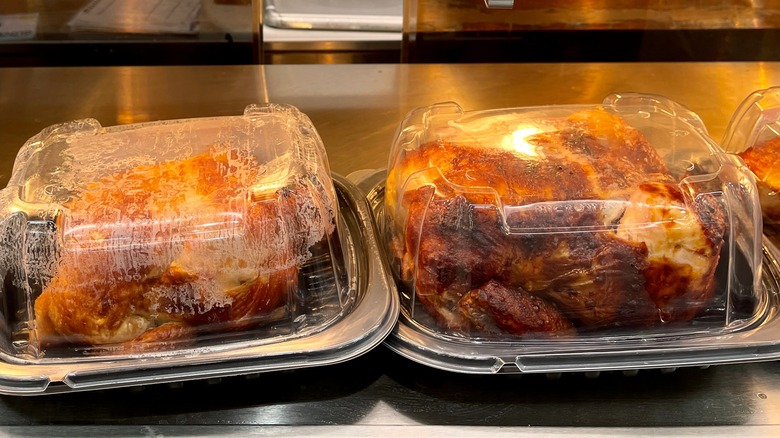12 Tips For Picking The Best Rotisserie Chicken
A good rotisserie chicken is pretty easy to find. Nowadays, most major supermarket chains sell them, with some smaller neighborhood joints also offering this succulent, just-cooked delight to their customers. Rotisserie chickens are tasty, reliable as they come, and offer high amounts of quality protein for a good price, usually coming in cheaper than the raw alternative. You can even get an extra meal out of them once the meat's gone, if you play your cards right.
Here's the thing, though: We don't just want a good rotisserie chicken. We want the best one. Picking a rotisserie chicken can be surprisingly difficult, and while you usually go home satisfied, going home knowing you've bagged the best of the bunch can be harder.
So what's the trick? It turns out that there are loads of signs that can flag which rotisserie chicken is the best — you just have to be in the know. Weight, size, and uniformity of skin are all things to look out for. It also pays to know exactly when to go to the store to ensure you're getting the freshest option, and what temperature and storage conditions to keep an eye on. We've cracked the code on how to get the best chicken for your buck, and we've got all the tips you need right here.
1. Go to the store at the right time
Everyone wants their food to be as fresh as possible, and when it comes to rotisserie chickens there are no exceptions. To ensure that they're at their peak, it's best is you can buy them when they've just been cooked. It's worth remembering, however, that cooking times can vary from store to store. Whole Foods Market, for example, will usually start cooking its chickens just after the store's opened (usually around 7 to 8 a.m.), meaning that the first fresh batch will be hitting the shelves between 11 a.m. and 12 p.m. If your local supermarket opens earlier or later, though, the chickens could be cooked at a different time.
Don't worry if you can't make it to the store during the day, though. Most supermarkets will cook rotisserie chickens at intervals throughout the day, to ensure a steady supply of fresh produce. In fact, a lot of stores will purposefully ensure that their biggest batches are being cooked to coincide with evening shopping hours to cater to an after-work crowd. As every retailer will be different, the best way to tell when your store will be cooking their chickens is simply by asking them.
2. Opt for the heaviest chicken you can find
When picking out a rotisserie chicken, most of us do so using our eyes first. However, if you want the best chicken money can buy, you have to actually pick them up. You should be buying the heaviest rotisserie chicken every time because it indicates that the meat is still full of moisture. The longer that chickens sit under the heat lamps, the more the moisture in it seeps to the surface and evaporates, or else drips out into its container. This leaves you with tough, dry chicken, instead of the plump, juicy thighs and drumsticks you're craving.
So, if your chicken feels noticeably light, leave it there and try to find another one. If the chickens are kept behind a screen, meaning you can't handle them readily, ask the person behind the counter if they can pass a few to you to assess their weight. That's if they're already bagged, that is — if not, it could be worth asking the attendant to weigh a few different options to make sure you're getting the best one.
3. Make sure your chicken's skin is tight
Your chicken's appearance is a big clue as to how tasty it'll be — and you want to go for one with a smooth appearance. Taut skin can indicate that your chicken is still juicy, as opposed to shriveled skin, which means the juices have left the meat. Remember, the heat lamps that the chickens sit under are pretty intense (they need to be, to stop bacteria growing), and so as the meat rests, it'll continue to dry out.
As such, a chicken with tight skin can not just indicate that it's still full of moisture — it can also indicate that it's fairly fresh out of the oven. Don't just assess the skin covering its breast meat, either. Make sure you take a good look at its drumsticks and avoid any chickens that have puckered-looking legs. Picking a tight-skinned chicken will also ensure that its skin is crispy and light, instead of becoming gummy and chewy, which can occur as the meat dries out and the skin becomes moist. No-one wants that, guys.
4. Look at how much juice is in the container
We all want our chickens to be juicy, but we also want that juice to actually be inside the chicken — not, y'know, pooling at the bottom of the plastic tray it comes in. If you pick up a chicken where there's a lot of extra juice swimming around outside of the carcass itself, it's best to leave it where it is. Pools of juice at the bottom is a surefire indicator that the meat is no longer juicy, and has been sucked out of the chicken by the heat lamps. The meat will therefore be dry and unappetizing.
Instead, you should look for chickens that have barely any juice at the bottom of the container. This can indicate that they're fresh, and that the juice is still inside the meat itself. If the chickens are kept behind a glass counter and aren't already separately packaged, try to see if there's any juice around them — and then opt for the ones that look like they're retaining their moisture. If your store puts their chickens in paper bags, try to avoid any that have soggy bottoms or outsides.
5. Assess your chicken's temperature
While major stores usually have pretty rigorous standards and processes in place when it comes to their rotisserie chickens, others may be a bit more lax. That's why you should get a handle on your chicken's temperature. Picking out a chicken that's been kept in a hot environment, and one that's warm to the touch, will give you the best chances of it being safe to eat. Chickens should always be kept in displays heated to above 140 degrees F to prevent them from developing bacteria that could make you sick.
Therefore, "when you are touching it, it should be very warm to the touch, and it should be fully making contact with a heating environment so you know that it has been properly connecting to the surface," explains Jeff Nelken, a food safety consultant, via Fox LA. You should try to avoid chickens that are kept around the perimeter of displays, as these could be slightly cooler. If the display doesn't have its temperature shown anywhere, ask the store attendant what temperature it's kept at. However, if they state a number that's way higher than 140 degrees, it could be worth going elsewhere, too. Chickens kept at higher temperatures may be safe to eat, but they can also be more prone to drying out.
6. Avoid chickens with too many ingredients
The beauty of a rotisserie chicken is in its versatility — but that's a fact that a lot of stores forget. Many retailers offer rotisserie chickens that have seasoning blends already basted onto them, like lemon pepper or barbecue mixes that can give them a pronounced flavor. Now, that flavor may be all well and good if you're just planning on eating it plain, but if you're planning on adding the meat to other meals, these seasoning blends can get in the way. It's far better to buy a plain chicken and season it yourself when you get home.
You should also be wary of high levels of sodium, or other additives like sugar or carrageenan. These can be injected into the chicken as a brine, which helps to flavor the meat, improve its texture, and make it plumper. However, doing this also loads the chicken up with ingredients you might not want to consume. Brines can be used in even the simplest-looking rotisserie chickens, so if you have any doubts, check the ingredients list or ask the attendant what goes into them. The best-case scenario is to opt for an organic, antibiotic-free chicken that has little to no sodium. By doing this, you can take your chicken to the next level your own way.
7. Look at its time stamp
If you want to know how fresh your chicken is, take a look at when it was cooked. Not all stores will use timestamps, but in places like Costco it's a must. "They time stamp the rotisserie chicken so that it's only on the shelf for two hours because it doesn't taste as good after two hours," says David Schwartz, co-author of "The Joy of Costco: A Treasure Hunt from A to Z," to Business Insider. Once those two hours are up, Costco employees will then repurpose the chicken, shredding it and placing it in some of the store's other deli options.
However, you can use this two-hour rule in pretty much any store where you're buying your chicken, provided that they've time stamped their meat. The closer your chicken is to the time stamped on its container, the fresher it'll be — and if it's over two hours after that, you should avoid it in favor of another one. If your chickens aren't time stamped, never fear. Just ask the attendant when they came out of the oven. If it was a good while ago, it might be worth watching for the next batch to be cooked.
8. Check out the chicken's drumstick joint
The key to getting the best rotisserie chicken may be tucked away on the chicken itself. See the joint where the chicken leg meets the body? If there's any gap or split there, you should leave that one where it is. There should be no exposed meat at the drumstick joint, and the chicken skin should be totally intact with no rippage. If there is, it means that the skin has begun to dry out, pulling apart at the joints, which indicates that the chicken has been sitting there for a while.
It can also mean that the meat itself is going to be dry and tough — both because it's not been recently cooked, and because the skin splitting gives the heat direct access to the chicken's interior. You should instead look for a smooth joint between drumstick and body. The same goes for any of its other joints, like the point where the wings attach to the main carcass. If the skin is splitting anywhere it shouldn't (like on the breast portion of the meat) it should also be avoided, as this could indicate that the chicken's been poorly handled.
9. Assess your store's preparation areas
Before you pick up your rotisserie chicken, take a peek behind the counter...not at the food, but at the preparation area that sits behind it all. How is it looking? Is it clean and tidy, and does it look as though it's sanitized regularly? Or is it dirty, messy, and haphazard?
If it's the latter, you should avoid those chickens at all costs. Rotisserie chickens aren't like other supermarket groceries, as they have to be handled and prepared in-store by the staff. If the store's preparation areas don't look up to scratch, this could indicate poor practice or training — which can lead to some disastrous consequences. Not only might it mean that your chicken is poorly-prepared and cooked, leaving it tasting worse than it could, but it could also be a sign that hygiene rules and standards aren't being followed.
Remember that stores have a responsibility to provide specific training to their staff about how to handle and prepare fresh food — and it doesn't make you fussy to want your food to be sanitary. If you have any doubts about how it's been prepared, don't feel bad about picking your rotisserie chicken up elsewhere. Your health might thank you for it.
10. If you're eating today, try to get the reduced chickens
Everyone loves hunting for a good bargain — but when it comes to freshly-cooked food, like rotisserie chickens, we can be a little more squeamish about it. We can definitely see why. It can be harder to know exactly how fresh the food was before it was cooked, and how long it's been sitting out, leading many to assume that when fresh foods like rotisserie chickens are reduced, it's because they're about to go bad.
However, that may not be the case, and if you're looking for a chicken to eat today (or want to buy one to freeze and use in leftovers), don't be afraid of the reduced price options. Doing this is a great way to save those all-important dollars while still getting a chicken that's just as good as a regular-priced one. While a reduced item can indicate that it's almost at its expiry date, it's worth remembering that it's likely still within a perfectly acceptable timeframe for eating, providing that you're going to chow down on it quickly.
So, when is the best time to get these elusive reduced price rotisserie chickens? Heading to your store the day before a holiday is a great move, as supermarkets want to shift stock that will expire over the period that they're closed. Going shortly before a store closes can also help you get the best deals. If there are any chickens left, they'll likely want to sell them fast.
11. Head to smaller stores for the best chickens
Supermarkets build their brand loyalty on being reliable and consistent, making them a superb place to buy reliable rotisserie chickens. However, assuming that they make the best chickens out there is a big myth. Opting for smaller neighborhood stores can help you find products that are way more flavorful and unique. For instance, some of the smaller, ethnic grocery stores might use unique spice blends on the rotisserie chickens.
It's wise to keep an eye on is how popular the store is. If there's a long line for its chickens, it's a good indicator that it's a locally-loved option. These stores may not cost the world, either, with many of them pricing their goods reasonably to keep up with competitors. Besides, shopping at smaller stores also means that you're not lining the pockets of already-wealthy CEOs, and are instead contributing to your local economy and helping small businesses survive. If that isn't a reason to look further afield than your local Walmart, we don't know what is.
12. Look for contact with the lid
If the store you're buying your rotisserie chicken in sells it in a box, check out how snugly it fits. It might seem like a rotisserie chicken that looks like it's been crammed into the box, nudging up against the lid, is a messy choice. However, the more it's poked up against the top edge, the more meat you're going to get. One shopper who bought a rotisserie chicken at Costco revealed on Reddit that this is an insider tip from the employees themselves. "A rotisserie guy working behind the counter once told me to always grab one that's touching the top of the container. An instant judge of getting a bigger chicken," they said.
This is a particularly useful tip when shopping at stores like Costco, where the chickens are consistently-priced, instead of priced by weight. Unfortunately, when it comes to Costco itself and its iconic $4.99 rotisserie chicken, this may not be a viable strategy anymore. The retailer has recently moved to using plastic bags instead of resealable containers for its rotisserie chickens in a bid to make one of their flagship products more environmentally-friendly. You can still use this nifty tip in other stores that use boxes, though — and you can still assess how big Costco's chickens are through the transparent window in its new bags.
